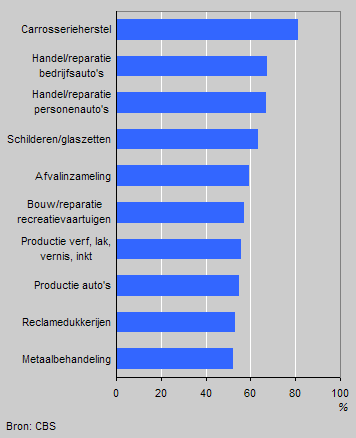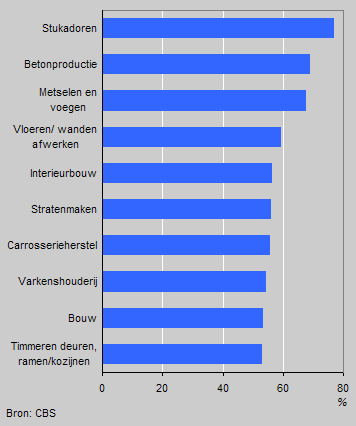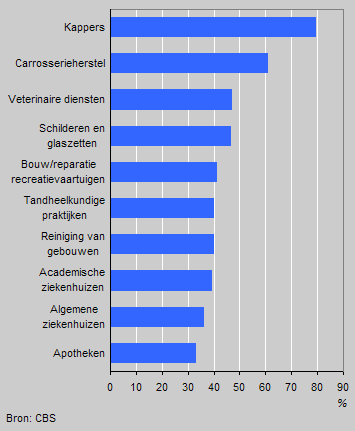Gases, fumes and dust in the workplace

On average nearly 15 percent of the employed labour force were exposed to gases or fumes in the workplace in the period 2000/2002. Ten percent of workers work in a dusty environment and another ten percent work with substances that irritate the skin or with biological waste. Fewer than 4 percent of workers come into contact with animals in the course of their duties.
Top ten industry classes where workers are regularly exposed to gases or fumes, 2000/2002

Gases or fumes
The burden of gases and fumes is largest in the sectors involving work on cars: body repair shops, car trading and car repairs. Eight out of ten workers in body repair shops regularly work in an environment where gases or solvent fumes or exhaust fumes are present.
Painters, glaziers and refuse collectors complete the top five.
Top ten industry classes where workers regularly work with chemicals, 2000/2002

Chemical substances
There are a number of construction related sectors in the top ten sectors of industry where workers are regularly exposed to chemical substances. More than three-quarters of plasterers, for example, regularly work in a dusty environment. Workers who have to mix whitewash, cement, sand and gravel for construction concrete, and bricklayers also come into contact with very fine particles.
Skin irritants
Nearly eight out of ten people who work in hairdressing regularly work with substances that may irritate their skin. Car body repair shops and veterinary services come next on this list, while health care workers, too, use detergents and disinfectants more than average.
Top ten industry classes where workers regularly work with skin irritants, 2000/2002

Biological burden
The top ten sectors of industry where workers are exposed to bacteria, mould and viruses is not very surprising. These are sectors where people work with animals or biological waste (food leftovers and vegetable and fruit waste).
The top four places are taken by sectors where animals are kept or bred. Veterinary services and abattoirs follow on the list.
More than three-quarters of people working in shops selling potatoes, vegetables and fruit, and flowers and plants regularly come into contact with biological waste. Workers in hotels, restaurants, bars and pubs are also exposed to biological waste.
Ingrid Beckers
Source: StatLine (Dutch only)